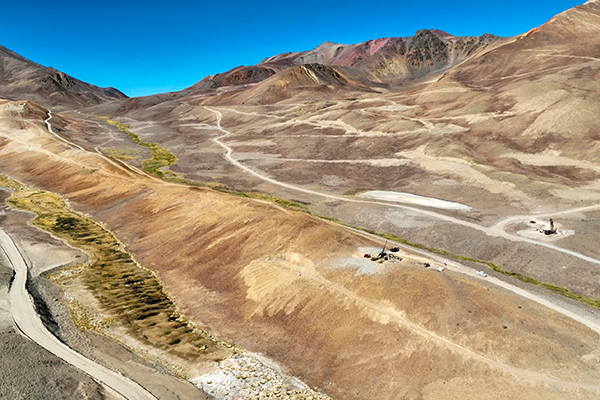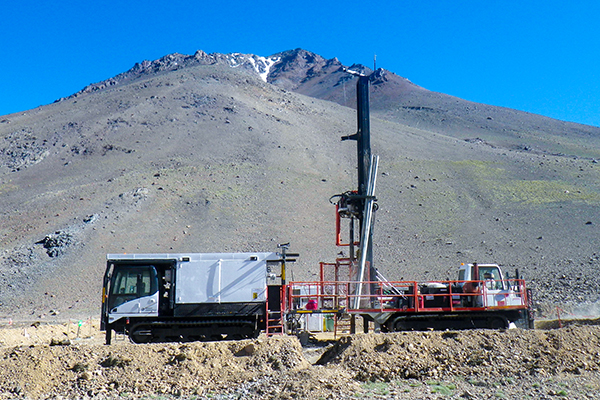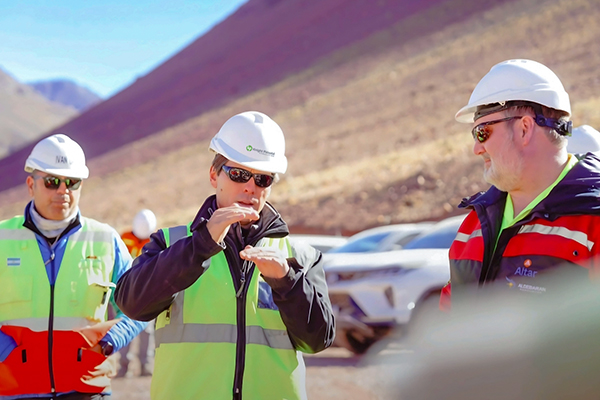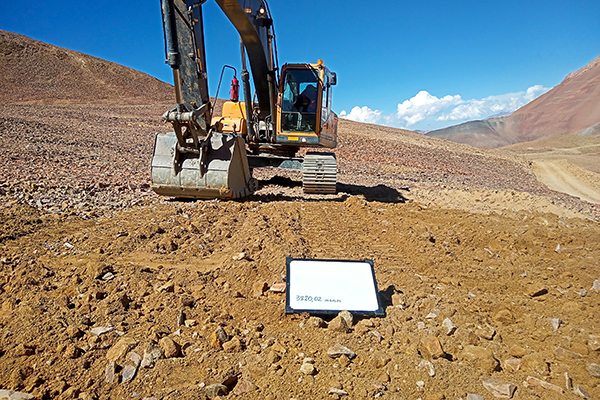
Los Azules Project
Client
McEwen Mining Inc.Location
San Juan, ArgentinaHighlights
- Geotechnical investigations comprising 197 boreholes across all project areas, with a total of 12,468 m of drilling
- Environmental studies, including baseline studies, environmental management and closure plans, and the Environmental Impact Assessment for the production phase
- Design of the heap leach pad, open pit, waste dumps, stockpiles, water management systems, water balance, mine closure plan, and wetland removal plan
- Characterization of semi-annual hydrochemical variability

Overview
Los Azules is a high-grade open pit copper porphyry exploration project located in the province of San Juan, Argentina, approximately 80 km west-northwest of the city of Calingasta and 6 km east of the Chilean border, at an elevation of 3,500 meters above sea level in the Andes Mountains.
After receiving approval for the project’s Environmental Impact Assessment (EIA), McEwen Mining Inc. (McEwen) is planning to complete a feasibility study in 2025. With an estimated investment of $3.5 billion, subject to schedule and permitting, early works are expected to begin in early 2026, followed by construction in 2027 and commercial production in 2029. Los Azules is projected to produce an average of 155,000 tonnes of copper per year (equivalent to approximately 342 million pounds) over a 27-year mine life, resulting in an annual output of 146,057 tonnes of LME Grade A refined copper cathodes.
Knight Piésold has supported the project through more than 50 assignments. Since the early stages, McEwen has relied on Knight Piésold to lead geotechnical site investigations that define foundation parameters for key infrastructure. This has included managing drilling, test pitting, and laboratory testing over three field seasons between 2022 and 2025. Additionally, Knight Piésold has provided feasibility-level engineering design and environmental studies in preparation for the construction phase.
The project envisions an open pit mine that will process leachable copper in the initial phase through heap leaching, along with a solvent extraction and electrowinning (SX/EW) facility to produce LME Grade A refined copper cathodes.

The Challenge
McEwen faced a challenging work plan, accelerating environmental studies in parallel with engineering designs and drilling program expansions, to prepare a construction plan that would allow a 2026 start. Knight Piésold was selected as the environmental and engineering consultant to secure regulatory approvals, while working within the short timeframe and delivering high-quality technical outputs.
Key challenges included optimizing water balance, designing infrastructure adapted to complex geological conditions, and mitigating environmental impacts. Ensuring geotechnical stability requires advanced investigations and precise modeling to assess and manage potential risks. Addressing these challenges is essential for Los Azules to align with international best practices.

Our Approach
Knight Piésold has played a pivotal role in the Los Azules project, delivering high-value services based on a targeted approach to addressing data gaps critical to project advancement. This strategy has enabled a smooth transition from the Preliminary Economic Assessment to the feasibility engineering phase, while maintaining environmentally responsible and technically sound solutions.
A key priority has been strengthening environmental monitoring and management. Knight Piésold has completed baseline studies, including hydrological, hydrogeological, flora and fauna, archaeological, and paleontological aspects, to provide a comprehensive technical framework for decision-making. Knight Piésold has also prepared the EIA and its updates, developed environmental management plans, and implemented biological and hydrogeological monitoring programs to promote responsible resource development.
The design approach has emphasized the use of advanced modeling tools to optimize core infrastructure such as the heap leach pad, waste dumps, stockpiles, and open pit. These tools have supported effective water balance management and long-term structural stability, in full compliance with Argentina’s mining regulations.
Knight Piésold’s multidisciplinary capabilities have contributed to seamless integration of environmental and engineering aspects, enabling the delivery of safe, sustainable, and internationally compliant project solutions.

The Results
Knight Piésold has made a significant contribution to the Los Azules project. Knight Piésold has developed a robust geotechnical database essential to project advancement. Investigations were completed across core infrastructure, including the heap leach pad, waste dumps, stockpiles, and open pit. The initial geotechnical site investigation program that began in December 2022 included 33 test pits. Based on those results and in alignment with overall engineering development, two additional large-scale geotechnical campaigns were executed. The second site investigation program was carried out from October 2023 to May 2024, covering 63 sonic boreholes (with a total of 1,489 m of drilling) and 68 diamond drill holes (with a total of 6,853 m of drilling). The third program was carried out from November 2024 to January 2025, consisting of 31 sonic boreholes (with a total of 756 m of drilling) and 35 diamond drill holes (with a total of 3,370 m of drilling). More than 300 test pits were excavated to evaluate borrow materials, accompanied by a comprehensive laboratory testing program.
Knight Piésold’s in-house geotechnical laboratory has been instrumental in maintaining timelines and delivering timely engineering data, while working closely with a trusted network of external laboratories. The site team included 20 specialized professionals, including geotechnical engineers, geologists, soil technicians, HSE specialists, and document control staff. As a result, the drilling database was expanded to 12,468 m, marking the largest geotechnical investigation program ever conducted at Los Azules and one of the most extensive in Argentina.
On the environmental front, Knight Piésold has led the environmental baseline studies and EIA, conducted biological monitoring, and developed environmental management and closure plans. The approval of the EIA was achieved in November 2024, following detailed reviews by the Ministry of Mining and other regulatory bodies, culminating in a public consultation process and a formal site inspection.
At the engineering level, Knight Piésold has played a key role in advancing the project into the feasibility phase. Conceptual engineering designs were optimized through advanced hydrological and hydraulic modeling and numerical modeling, improving the precision and efficiency of water management planning. Water quality and resource management were addressed through the analysis of data collected from eleven monitoring campaigns, using internationally recognized methods and aligned with Argentine regulations. The integration and validation of meteorological, hydrological, and hydrogeological data has helped develop a strong water management strategy and allowed for the characterization of hydrochemical variability—reinforcing Knight Piésold’s commitment to innovation, quality, and sustainability.